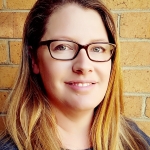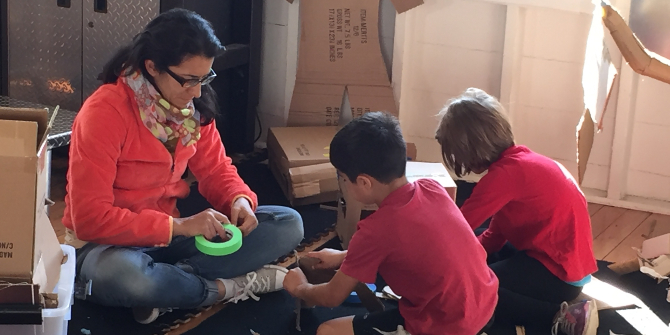 How do the Australian Department of Health and Ageing’s new screen time guidelines sit with the latest research about screen time? In this blog Jane Mavoa highlights the problems around a lack of robust evidence informing official guidelines. Policy falls behind the latest push to focus on content and context of screen time, rather than just quantity of hours. Jane is a PhD candidate at the University of Melbourne, Australia, researching how children play in digital realms and how this relates to other elements of their overall ‘play worlds’. [Header image credit:S. Dreilinger, CC BY-NC-SA 2.0]
How do the Australian Department of Health and Ageing’s new screen time guidelines sit with the latest research about screen time? In this blog Jane Mavoa highlights the problems around a lack of robust evidence informing official guidelines. Policy falls behind the latest push to focus on content and context of screen time, rather than just quantity of hours. Jane is a PhD candidate at the University of Melbourne, Australia, researching how children play in digital realms and how this relates to other elements of their overall ‘play worlds’. [Header image credit:S. Dreilinger, CC BY-NC-SA 2.0]
The Australian Department of Health and Ageing has recently released a new set of guidelines setting healthy targets for overall sedentary behaviour, sleep and screen time for 0- to 5-year-olds, with the ‘screen time’ component informed by a systematic review of literature linking it to a range of health and psychological outcomes. They are quite similar to the set they replaced – advising no screen time for 0- to 2-year-olds, and no more than an hour a day for 2- to 5-year-olds.
Misguided guidelines
These guidelines are actually out of step with recent calls to change tack on how parents are advised to approach children’s screen-based media use. This push for a shift in focus was spurred on by the influential American Academy of Paediatrics’ 2016 policy statement urging consideration of the content and context of ‘screen use’. While media scholars have critiqued the statement for not quite hitting the mark, the overarching shift from talking about ‘screen use’ as a monolithic entity to something more multidimensional has largely been applauded.
So why have the new guidelines failed to reflect this broader shift in approach? It must be noted that the Australian government is not alone in this regard – New Zealand released a similar document in May 2017, and international advice is still heavily dominated by a harm-reduction approach, about restricting and reducing screen time.
Perhaps one clue lies in the make-up of the leadership group and consensus panel charged with forming the guidelines – only one member has expertise, or academic interest, in children’s media practices beyond the number of hours a child spends in front of ‘a screen’. Expertise in and research about how children actually use media seems to have been beyond the scope of the project, which represents a potentially significant gap.
Methodological problems
There are also methodological problems associated with the types of research that are included:
- It is difficult to conduct randomised control trials in this area, and their resulting lack in the evidence base means it is difficult to establish causation.
- The studies measure ‘screen use’ in high-level chunks of time, differentiating type of ‘screen time’ being measured, if at all, by arguably meaningless categorisations such as time spent ‘watching TV’ or ‘using the computer’ or ‘using the internet’.
- There are no robust accounts of the role of individual differences in the ways that children might respond to media.
- The process of measuring ‘screen time’ is increasingly problematic as media use becomes more converged and ubiquitous. For example, is a child asking Siri to set a timer so that they may count how many laps of the park they can run in 5 minutes counted as ‘screen time’? How would a parent report this on a questionnaire asking them to tally up the total number of hours the child has spent engaging in ‘screen time’ during the course of a day?
- The systematic review used specifically states that studies that considered differences in content were excluded, so all of the research looking at what makes for ‘good’ TV, or ‘good’ digital play, and the potential positives found in that body of work, are simply not part of the picture.
- Because the studies rely on statistical modelling that involves only being able to control for researcher-determined (easy to measure and quantify) covariates, like parental education level, mother’s weight, child’s ethnicity etc., the subtleties of children’s everyday practices are necessarily erased.
This kind of research, and the results it produces, allows for statistically meaningful associations to be made between ‘screen time’ (as measured) and a range of health or other developmental outcomes, which lend themselves well to simple, punchy guidelines.
But ultimately, the trade-off for being able to draw neat connections is a loss of valuable information. For example, it is likely that in the hard-to-quantify contextual detail we may find explanations for the amount of inconsistency in the results of these quantitative studies. In the systematic review underpinning the guidelines, 72 unfavourable associations were found between ‘screen time’ and some health or development outcome, but a slight majority of tests for associations, 82 in fact, found none (five found favourable associations).
When even the very notion of ‘screen time’ as a construct is frequently being called into question, methods that rely on stripping back crucial information reflective of the realities of children’s lives, and the sets of knowledge those methods produce, appear increasingly not up to the task – at least, not in isolation.
‘Screens’ have been part of children’s lives for well over half a century, and we have been asking questions about their effects for just as long. The types of problems mentioned here, and the resulting harm-focused guidelines in Australia and elsewhere, are not new, with many often mentioned in ‘limitations’ sections of published research.
Filling in the gaps
Surely it is time to move on from acknowledging, then ignoring, the significant limitations that studies from medical(ised) fields have in their ability to answer questions about the complex relationships between children and screen-based media? Including knowledge from a broader range of fields would help fill the gaps currently left by the medical and epidemiological literature.
Government departments should start with a thorough, broad literature review, which would guide the selection of an appropriate group of experts, diverse in terms of knowledge bases and areas of interest. A wealth of information is available in the fields of media and communication studies, education, sociology and anthropology that is currently largely absent from evidence bases.
Much of this work, including research conducted in the Australian context, includes rich, contextual information. For example, several observational studies looking at instances of digital play reveal not only a great deal of fluidity between digital and non-digital play, but also the central role of language in the highly engaged practices of negotiation, collaboration and shared enjoyment that surround social digital play. Such activity captured by the types of research currently underpinning guidelines would simply appear as ‘x’ number of minutes of ‘screen time’.
A truly cross-disciplinary approach would undoubtedly present its own set of challenges – synthesising quantitative and qualitative results may prove more difficult than working solely in p values and proportions. However, such challenges need not be insurmountable. At stake is a clearer pathway to robust evidence bases likely to produce more meaningful and, ultimately, better quality guidance for parents and others involved in raising children with a digital future in mind.
This post gives the views of the authors and does not represent the position of the LSE Parenting for a Digital Future blog, nor of the London School of Economics and Political Science.





